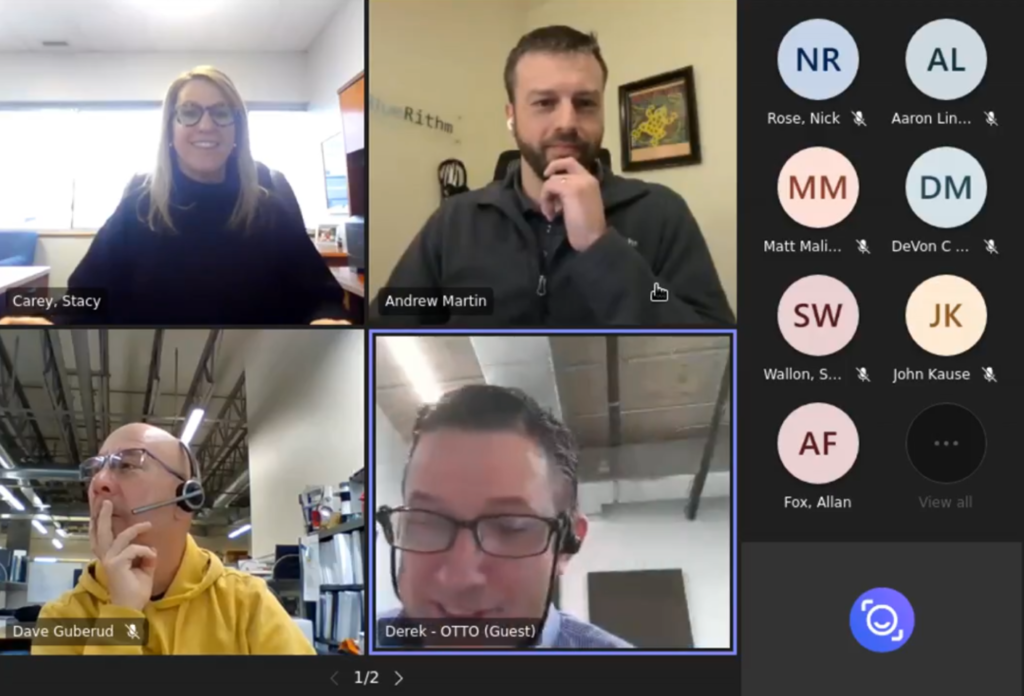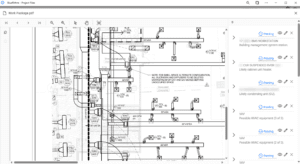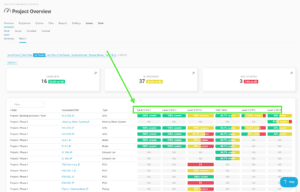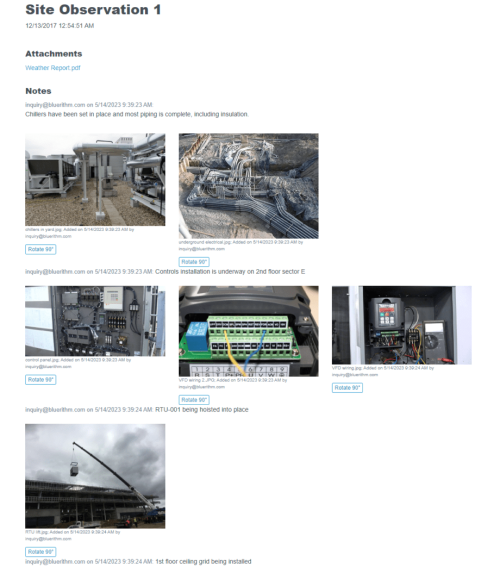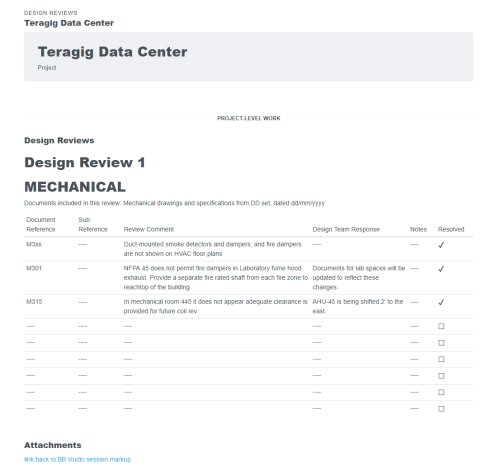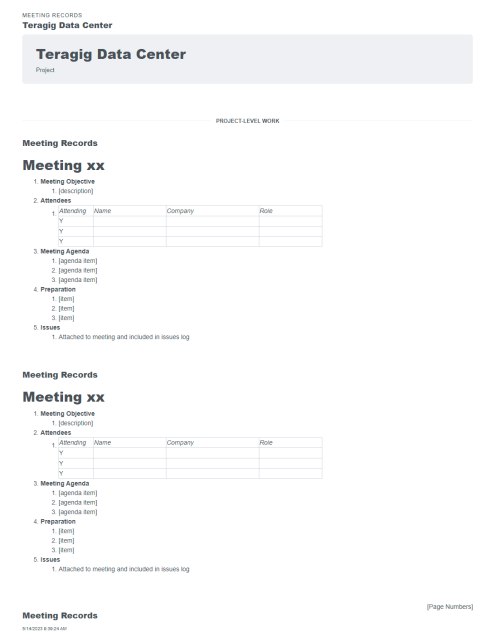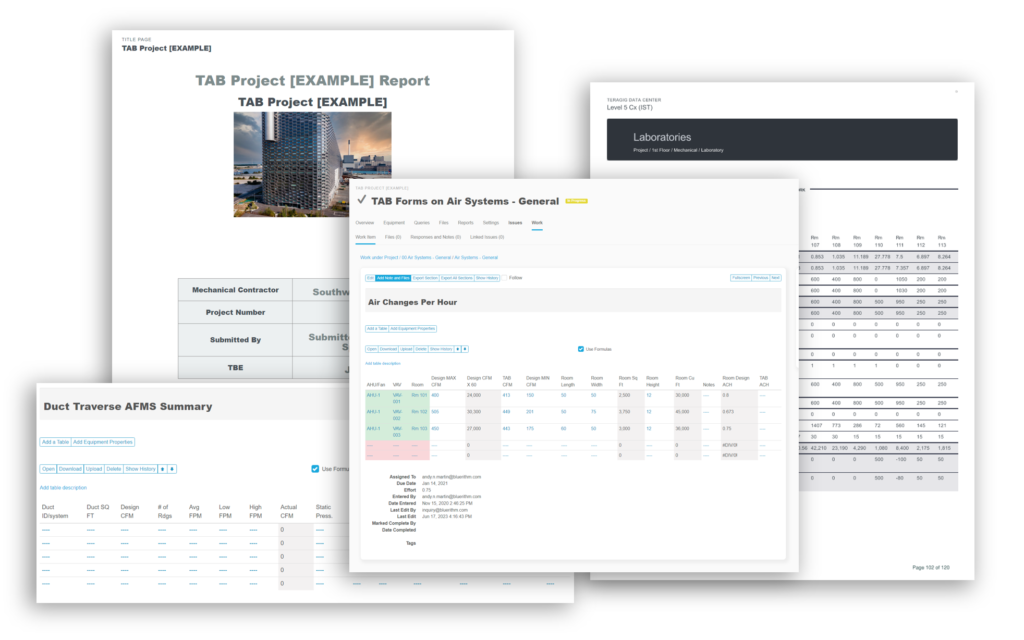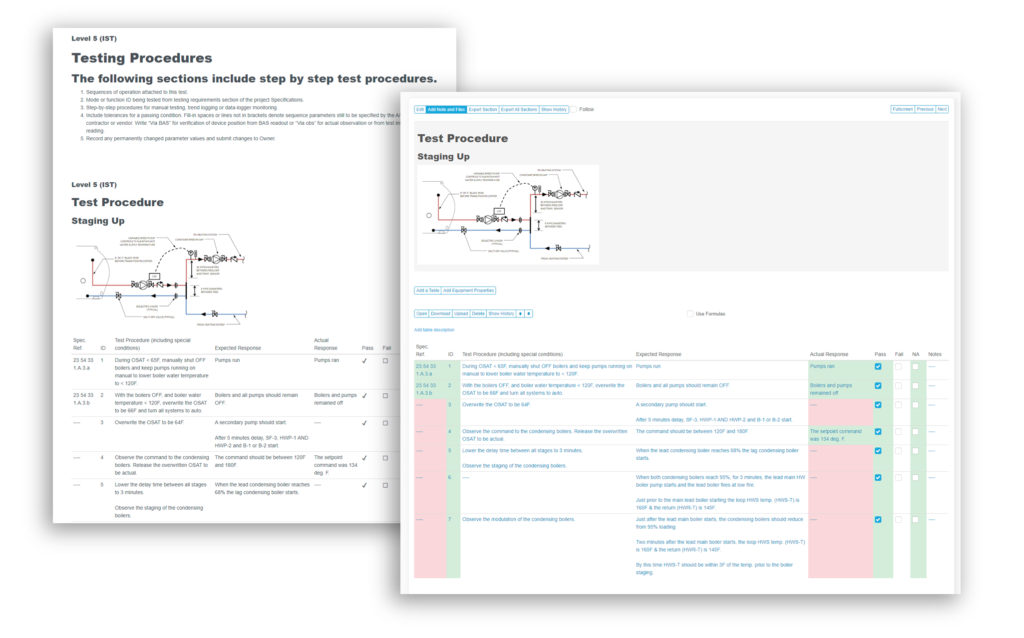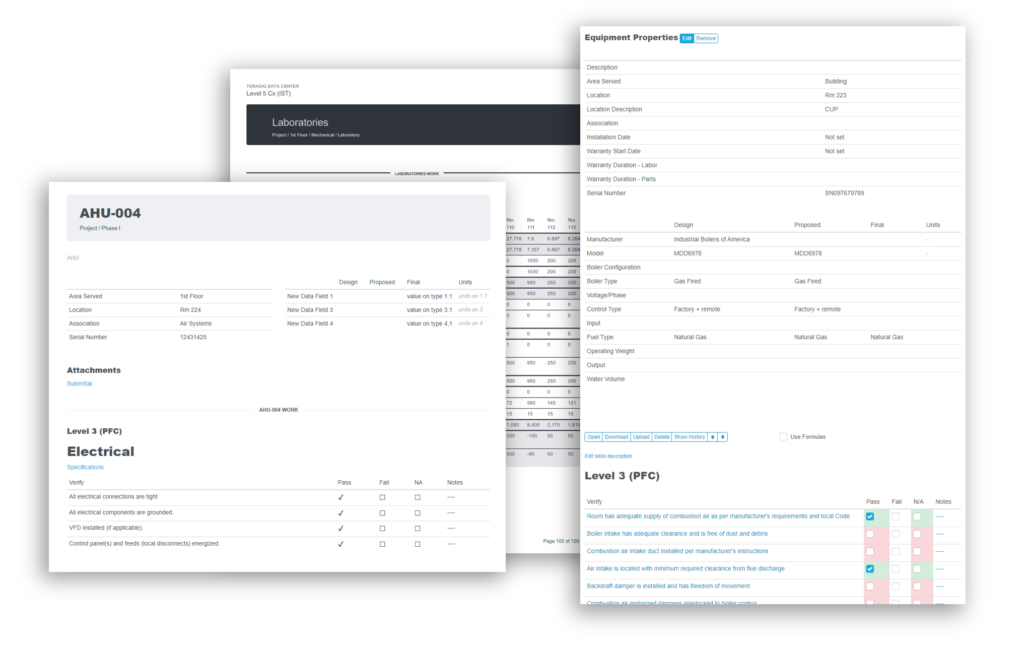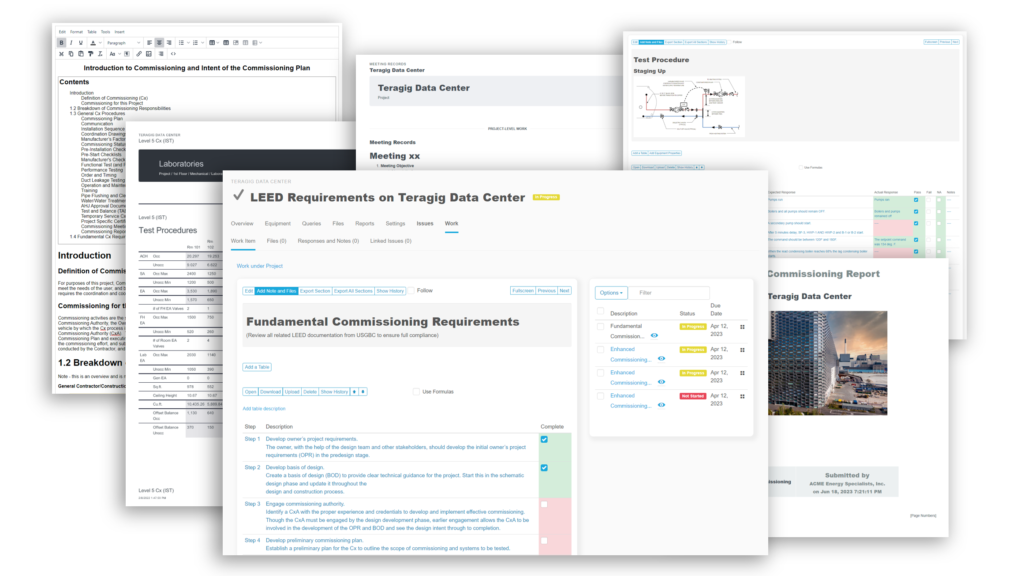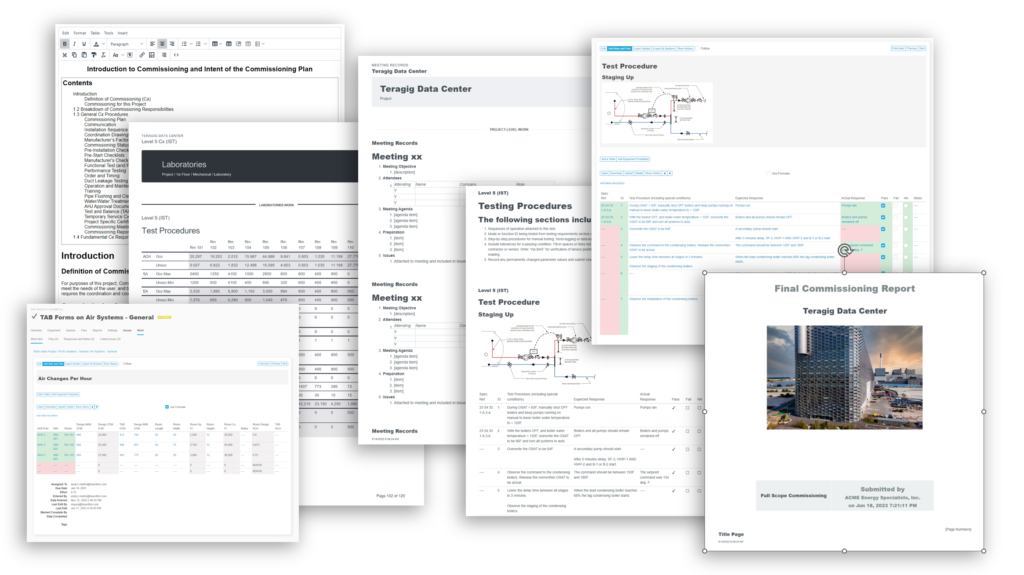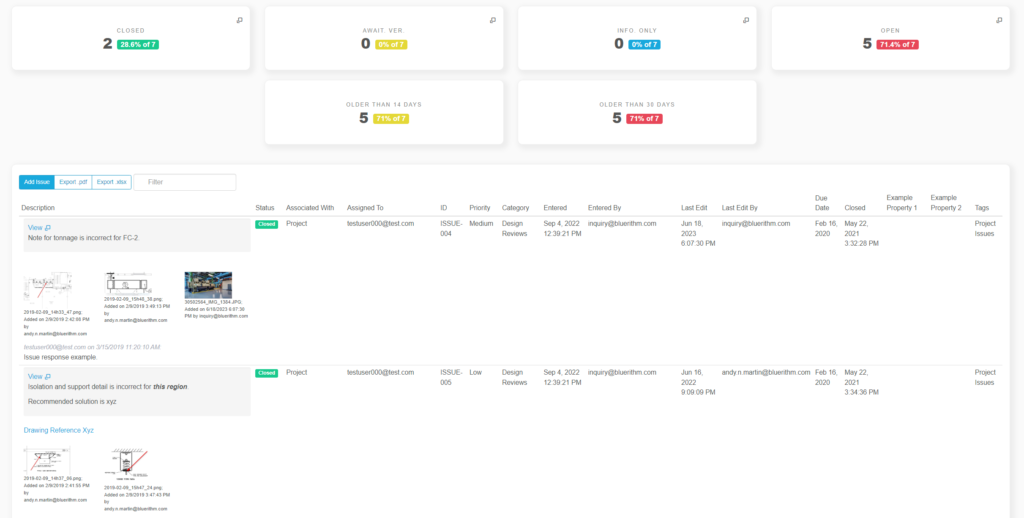Transcript
Stacy Carey: [00:00:00] We have a great attendance so far. It looks like we have about 33 people in the meeting. Good morning and thanks to everybody for joining. I’m excited to get the central chapter together and do a tech talk. We as the board decided to talk about AI and commissioning. It’s something that we’re all hearing more and more about and are really interested in seeing where things are headed.
And really wanted to bring in some industry experts just to have a conversation about where things are headed, answer some of the questions maybe that we have. So, this isn’t meant to be a formal presentation. It really is going to be a question and answer. So, the board put together just a handful of questions about AI and some things that we were curious about.
I did send those ahead of time. I’m going to introduce Andrew Martin or Andy Martin from Bluerithm and Derek McCary from OTTO are here today as our industry experts to talk to us about what they’re seeing in the industry with their companies. [00:01:00] And I’m just going to go ahead and maybe let Andy and Derek, would you mind introducing yourself just for those on the phone that may not be familiar with your companies?
Stacey, are we going to record this?
Yes, that’s a great idea. Let me do that now. Okay, yep, we’re good to go. It’s recording.
Andrew Martin: Derek, why don’t you go ahead?
Derek McGarry: Okay, sure. I’m Derek McGarry. I’m a professional engineer. I got started in HVAC in the late 90s and got turned on to analytics technology probably around I want to say 2010 or 2011 and fast forward 12 years, I’ve been head in HVAC analytics, which is, we’ll talk about this a little bit of a subset of, or involves AI and Yeah, so my goal with OTTO which we started three years ago, is to put the analytics technology, make it easier to get into the hands of commissioning providers.
So, we serve commissioning providers and make technology easier for them to deploy. [00:02:00]
Andrew Martin: Hi everyone. I’m Andrew Martin, the president and founder at Bluerithm. We have a platform that just helps streamline the commissioning process workflows collaboration, all of that good stuff. My background is also in the industry. I came up starting out as a person sitting on a bucket in the mechanical programming systems did a lot of different things, ran some big projects, big multimillion dollar contracts, part of the design teams and in 2016, I founded Bluerithm. And I have a little bit of a background in software. So, I combined my different areas of knowledge and created this company.
And I’ve been working on that ever since and been having a great time.
Stacy Carey: Okay, thank you both so much. Okay, I’m just going to get it kicked off here with one of the questions that the board put together and then again if you guys want to everybody on the call use the little raise your hand if you have a question and we’ll allow questions from the audience, again we just want this to be an open discussion.
Bring your questions in. As we go along it’s not a [00:03:00] formal presentation. Okay, so what is AI as it relates to commissioning and how will AI help the commissioning process?
Derek McGarry: Andy, you want to start us off?
Andrew Martin: Sure. So, the big question, of course I think when we’re talking about AI right now in this context, what’s getting a lot of attention is the generative AI. So, AI as a subject, as a research topic has been around for a long time, like decades.
But it was really when ChatGPT released their product last year, about a year ago, that it started to get a lot of attention and the combination of technologies that’s behind something like ChatGPT makes up generative AI, artificial intelligence. So, they’re using large language models, which is a whole bunch of underlying technologies and just built on these decades and decades of research.
So, from that [00:04:00] standpoint what does that mean for commissioning? These large language models are really good at certain things. Interpreting, ingesting, reviewing summarizing, and actually reasoning about lots of information at one time. For example, when ChatGPT first came out you could just copy and paste some text in there, and it could reason about it a little bit.
But now, just a year later, you can upload massive documents so not even just raw text. You can upload a PDF file, for example, specifications and it can interpret that in seconds. Give you a summary about it, tell you where there’s errors, tell you where there’s conflicts and actually apply reasoning and a lot of intelligence to it.
And then you can ask questions about it, of course. So that’s just the baseline general use product like ChatGPT, Google has stuff out there now and there’s lots of other things out there too. Of course, for commissioning, everybody’s spending a lot of time just ingesting information and reading and just interpreting stuff and just trying to make sense of it and connect all the dots.
So, AI can be a tremendous help in that sense. And then [00:05:00] the other big area that it can really help is and Derek’s going to talk a lot about that too, from his standpoint, just ingesting data from buildings and systems and, analytics and what it can do with all that. But then on the other side, what these large language models can do really is actually generate content.
You know out of thin air create content just you know we do when we’re writing a story or when we’re writing specifications or writing test procedures. It can actually create that content based on its underlying models that they’ve been trained on you know, the way these work they’ve spent hundreds of million dollars training these big models basically sucking up, the history of human knowledge from the internet.
And that’s the source that they’re drawing from, the general ones. And then they can also be more specialized and adapted to a specific use case. So, we actually have been working on some tools where we have an AI tool that, for example, can create test procedures. You can say, okay, here’s the sequence of operation.
Write me a test procedure for this sequence of [00:06:00] operation. And is it perfect? No, but they can do a really good job and, if it can get you 80 percent of the way there that’s still pretty impressive for what this technology can do these days. So, that’s in summary, to not get too long winded here interpreting and reviewing summarizing information and then generating content.
That’s what these large language models are really good at right now.
Derek McGarry: I’m glad you started Andy. I do not have as much of a software background. I’m coming from a mechanical perspective and quite honestly, the large language models that Andy’s talking about with ChatGPT and more recently Gemini, Google’s thing just came out. It’s quite overwhelming.
It’s quite overwhelming and it’s really hard to process in my head how it does what it does. But it’s amazing and I’ve only used the free version. And yeah, you can feed it a sequence of operation and feed it data from the actual operation and ask it what’s wrong. And it will provide an answer or answers.
And as of right now, like Andy’s saying, it may only get 80 percent [00:07:00] right but it gets you, it just organizes things so well. And I think what’s mind blowing is that this is I think it’s early days and we’re seeing an extreme acceleration and I’m just overwhelmed.
As soon as Alex, you invited me to this panel of course I had to do a lot more research to try to become smart on this stuff. And it’s both scary and exciting and it will change our lives, our worlds, whatever. It’s going to change lots of things. But let’s step back a little bit because it took us a long time to get to where we’re at in AI right now, and I say we as a, it’s not me. But it’s a, I don’t know what’s the word? A fungible term that can be used in a lot of different ways and it seems the definition seems to adjust, every decade.
There are lots of things involved with, business process automation is a general category, which could be considered AI and, tools like I’ve heard plenty of commissioning providers say that it’s transformed their business. Here at OTTO, our special thing is automated functional testing. I’m an engineer, I [00:08:00] think it’s amazing. It’s amazing what it can do, but I, with automated testing, with business process automation, as a mechanical engineer, I can’t get my head around it, and it’s, step by step, we’re making a functional test script, and we’re going to repeat it, a hundred thousand of times.
That’s the power. But the test itself, was a person putting it together. And now, as Andy’s talking about, you can have, a chatbot put it together and It’s just amazing. But I asked ChatGPT what AI and commissioning, how AI could be used in commissioning.
And the first thing it mentioned was fault detection and diagnostics with that acronym and everything, FDD amazing how it answered things, but it said, fault detection diagnostics, ChatGPT considers AI. Predictive maintenance, we hear a lot about that from a lot of software providers.
I’m not sure I’ve seen real mind-boggling examples of predictive maintenance, beyond the core of, is there a big, high pressure drop across a dirty filter, it’s time to change it. But it can get a lot more advanced than it is. [00:09:00] Commissioning process automation, that’s the documentation side of things, as well as testing, like we do analytics in general, KPI’s and then you have supervisory control, also considered AI.
So, there’s a lot of places where AI fits into our world. And outside of just, pure commissioning applications, I saw a good analogy the other day that really changed my perspective on things is that, I’ve been in whatever, the work world since the 90s and, using Microsoft Office all along the way.
They keep on adding new features. For someone I guess I’ll say of my age and, the older you get, it’s like the more you get a little overwhelmed and you don’t want to try these things, but the large language model essentially is going to enable us, everyone, to leapfrog all these features you’ve been ignoring and use them at ease.
It’s just look at that little sidebar over to the top right of any of your office applications, and you will find essentially AI embedded in there to help [00:10:00] you. And I don’t gather that many people use it, but or I certainly wasn’t, but it’s amazing.
So, I’ll stop there. That was, but it’s all over the place.
Stacy Carey: Yeah, no, that’s a good introduction. I think for us, I think we’re all over the place in terms of, I think, familiarity with what’s out there now and what’s coming. I think that was a great introduction. Next question would be, what are the security risks potentially for our clients?
And then, I guess in terms of confidentiality, if we’re using these chatbots or whatever we’re calling them to maybe develop sequences or I’m sorry, testing based on sequences, is there a risk, or should we be using them and using our clients’ processes, and putting that out there?
Have you guys heard anything about that, thought about that, or hearing where the industry is going? Entering information that might be our clients?
Andrew Martin: Yeah, and this is an important topic and this is also evolving quickly. That was one of the first kind of negative stories that came out [00:11:00] of all the hype around ChatGPT and again, there are other tools, but ChatGPT is just the well-known one.
And it’s very nuanced, like a lot of this is going to be, unfortunately. It really comes down to what the privacy terms are for this specific product that you’re using. And that has different facets to it too, right? If we’re just talking about a general tool like ChatGPT, they have different privacy terms for the free version that Derek mentioned, and then there’s a paid version, and then there’s enterprise versions, and then they also have their API, which other companies can use to interact with their AI models.
And they all have different privacy terms. And some of them are extremely restrictive or good or private, right? So, if your data is extremely safe in the same way that it’s safe when we’re using Microsoft Azure or Amazon AWS to store files and specifications and drawings, when you save something on Procore, for example, that’s sitting in an Amazon warehouse somewhere on one of their servers. It’s generally accepted [00:12:00] today that that data is safe and it’s not going to be accessible to anybody who’s not supposed to see it. For some of the more enterprise targeted AI tools, you’re going to have some of those same protections in place, but you really just have to understand like what they are.
And then the other side of it too, is a lot of software products like Bluerithm for example, OTTO, I’m sure there is as well, but we use dozens of different software products in our business to streamline, automate, and do all the things that we need to do. And almost every one of them is releasing AI features that are complementary to what that product is.
So, understanding what AI services they’re using is important too, because that’s going to get into the same nuances about privacy where your data is actually going to go once you send it to this other software tool that is then sending it to an AI model. Most of the companies out there that are embedding AI features in their products, they’re not developing the AI technology. They’re using somebody [00:13:00] else’s AI technology like OpenAI or Google or Meta or, Anthropic or whatever it happens to be.
Derek McGarry: Yeah, I would add to that reaction to this question about cyber is that with any software, we have a cyber risk and you’re making a connection to networks, or if you’re making a connection to networks it’s what’s on that network that’s at risk. And I’m not sure that AI itself is a threat to that security risk.
Although this may change going forward. But in terms of, Andrew talked a lot about the data side, it’s the food for AI is data, essentially. If you can leverage data inside of an enterprise that’s special, that no one else has access to, then that’s value.
Think about it as if you play around with ChatGPT, which I encourage everyone to do, it’s a really easy way to start blowing your mind, is another way to put it, but if you throw technical questions at it you’re going to get some surprisingly technical answers.
But I would imagine, that doesn’t have access to, for instance, all of the vast volume of ASHRAE [00:14:00] publications. That’s not internet data, I don’t think. So, when you think about it from a strategy perspective, think about the data sources that you care about and you have access to.
How do you harness that into an AI? And that data is then a cyber risk too. So, if you’re talking about personally identifiable information, that’s a big deal. But if you’re talking about, HVAC operational data that arguably has less of a concern to them in the enterprise, but it just depends, but it certainly opens up, I think new cyber threats, but at the same time it’s the same type of cyber stuff that we already are dealing with.
Stacy Carey: Okay, thank you. So, I guess this is a little bit off script of what we had put in terms of the questions that we put together ahead of time.
But how are you, both of your companies and products utilizing AI right now, do you have part of your products that are I think, Andy, you mentioned something about that, utilizing AI within your product. Can you talk a little bit about how that might be being used now, or what you’re planning to do [00:15:00] in the next phase with AI?
Andrew Martin: Yeah, so it’s really just from a high level it’s around the two main things that the large language models do well. So, it’s reviewing, interpreting, reasoning about information. So, like plans, like specifications, requirements for a project and as well as the content that’s already been generated for that project and then generating the content.
So, creating the process guides, creating the workflows, creating the test procedures. So, we’re at the early stages of that, but we have a lot of plans to leverage this and really try to take advantage as much as we can of what these tools can do and, remove work that’s adding less value to projects for people.
It doesn’t benefit your clients if you’re spending a lot of time, formatting Microsoft Word documents, for example, or, reading a specification that’s the same boilerplate specification minus the 10 percent change from the last project. There’s a lot of ways to leverage these tools to allow yourselves to spend more [00:16:00] time on things that are really valuable to the industry, to your client, to society.
A lot of people hear things like that and have a lot of anxiety about it. We feel that too, like we’re a software company and one of the things that these models do really well is write software. So, we have software engineers on our team that are like, what does this mean for my future?
In 20 years, it might be a different story. But right now, for the next 10 years, this is just going to significantly enhance what everybody’s doing. It’s not going to displace anyone. It’s a technology just like all the other tools we use our technologies that just enhance our productivity as a society, as industry, as commissioning providers, as software engineers.
Yeah, to circle back to the original question before I get too far down a rabbit trail here, we’re using it to interpret information, review, help people do that quicker and then create the content. So, you still need the experts there to review and say, yep, that’s right.
Or nope, that needs some tweaking. But just to do those things more efficiently.
Stacy Carey: Thank you. Derek?
Derek McGarry: Yeah, [00:17:00] so that’s this thing keeps on coming up that there’s always a last mile. There’s a last mile that I, at least right now and I agree with Andrew, at least for, I don’t know, the next 10 years.
It seems obvious to me that professionals are still valued to take that last mile. Now we can just do more, which is more productive. You hear at all these commissioning conferences that there’s a big, you’ve heard it for decades for that matter, that there’s a it’s hard to find qualified employees to commissioning providers, to bring them into the commissioning world.
AI tools have the potential to mitigate that challenge There’s no silver bullet, but that’s I don’t know where I’m going with this what this but back to the question. OTTO, yeah, we are not using large language model for anything right now. And I, but it’s totally jumped to the front of my radar and I need to figure out how to do it.
Like Andy said you don’t have to be an ML or AI developer or have that technical ability amongst your team [00:18:00] to use third party products. At OTTO we build off of SkySpark, that SkySpark software that most folks are familiar with. I could sit back as a business strategist and say, you know what I’m going to wait for SkySpark to come out with these AI features.
But they already have. They got, machine learning tool sets or whatever, algorithms available for your use. So, my team needs to figure out how to use that and we need to figure out, I need to figure out how to make applications out of it. But again, going back to more simple terms, fault detection and diagnostics and automated testing is AI to a lot of people.
And I think when you compare one of OTTO’s special things is we focus on new construction. So, it’s the theme in new construction, is business process automation.
Similar to Bluerithm and other, process management tools. It’s to make our jobs more efficient and do better for our clients it’s as simple as that. When you get into the existing buildings world, the theme is more along energy savings, and predictive maintenance and less so on [00:19:00] doing our jobs better. But, 95 percent of the work done amongst the folks on this call is in new construction.
And so, utilizing any kind of AI to make our process more efficient is going to make your business stronger and it’s going to make you stronger. I’m going to stop there.
Stacy Carey: I haven’t seen any questions come in from the audience. On the board, has anybody else noticed any questions we need to. Or you want me to just continue with our list.
Okay, so one of the questions we came up with, and I guess this is maybe more around automated testing and Derek, some of the things you were talking about with auto versus true AI, but who determines the success criteria for functional testing, like for, say a VAV box. So, if you’re doing the testing, is that something that commissioning providers are still saying, yes, this is good.
No, it’s not. Or is that part of the automated testing as well?
Derek McGarry: So that’s a great question. And I think it’s a [00:20:00] highly debated question or I don’t know, maybe that’s not a fair way to say it, but my response to that is, the sequence of operations determines the success criteria.
But when you think about the sequence of operations, there’s not really a success criterion in there. So, what’s next? You look at the specs, do the specs have success criteria in them? Not very much at least from what we see in specs. And then, so then, you go a bit further and I saw a wonderful presentation at the BCA conference.
I think it was last fall about the importance of the OPR and putting success criteria in the OPR. So that’s another place. Ultimately, commissioning provider is recommending or signing off on that. That’s the responsible party. If you want the core of the question may essentially be, if you’re using auto, who’s going to come up with those criteria?
The way we’re going to do it, we’re going to look at the sequence and we’re going to draft a script for you and you can change any of the thresholds you want. So, it’s all over the board, but ultimately, we’re making judgments on behalf of the [00:21:00] owner.
At the end of the day.
Stacy Carey: Andy, do you have anything to add there?
Andrew Martin: No, I think that’s a, I think that’s a good response.
Stacy Carey: Okay, and then another question, maybe feeding off of that with the automated testing, how much does that cost per unit, say VAV box, like compared to traditional testing?
Derek McGarry: Thanks for that question. To be fair, there are I make it my business to know about this. There are a handful of really awesome commissioning providers out there that are going down the path of automated functional testing in house with their own use of software.
And, the majority of the ones I’m aware of are all SkySpark based. Although one, they have their own platform that they’ve developed over the years. But for us, we product sized it for commissioning providers that don’t want to deal with programming and software setup.
We just give you credentials, log on, and you review results. But all in our typical new construction process I think take a hundred thousand square foot building, a [00:22:00] hundred VAV boxes, four to eight VAV air handlers, maybe a small chill water system, electric reheat, whatever.
We’re going to trend a hundred percent of everything, utilizing a cellular enabled gateway so you don’t have to worry about networking or I’m sorry about the owner’s network not being up yet and we’re going to trend everything and run as many retests as you want on those hundred VAV boxes for a three-month period is going to run you about 30 bucks a box.
So, you compare that to what you do manually or in your fee proposals for 20 percent sampling A lot of our clients will provide 100 percent testing to their clients, in competition with other commissioning providers that are only doing sampling because they can’t afford the labor to do 100 percent testing.
So, to be able to test every box for 30 bucks, that’s what 15 minutes of labor equivalent, and then compare that to what you put in your fee [00:23:00] proposals for the time it takes to manually test each box.
Stacy, we have a question from Nick.
Stacy Carey: Yeah, I think Alex had his hand up too. Thank you, Derek, that was really helpful to just have that snapshot of cost.
Okay, we’re going to start with Nick.
Nick Rose: Sure, I love the model of being able to digitally go through and test this because the time spent as we don’t get more hours, the chipset gets as many hours as it has processing power. But what is the benefit of having that versus the physical person standing there?
For instance, I’ve been on projects where the VAVs or the chill and hot water valves show that they are opening within the visuals, but an actual eyes on shows the valve is not doing the rotating, though it senses that its position should be, where does that avoid a situation where you have the thing telling you, yes, where in reality, [00:24:00] it’s not functioning.
Derek McGarry: Sure. Yeah, that’s a great question. It’s really uncomfortable, the idea of it has the feel of relinquishing something to a computer when you’re doing automated testing. The reality is it, most of our applications, by the way, are on terminal equipment zone level devices.
So, the risk profile, by the way, is real, real low on that. A whole other topic of people’s fears about this type of thing. But for testing a hundred BAV boxes, a human is fallible, we’re sitting there theoretically with our digital notepad, Bluerithm version, whatever and you’ve got 100 test forms that you’re counting on, oftentimes a junior engineer to fill out all the responses for.
You just can’t compete with a computer in that respect if you have defined questions, but then back to the human part of it is use the software to take a big load off of you. But now when you go to the site and you do your personal stuff, your onsite stuff, you’re armed with vision of what’s going on that you did not know before. And [00:25:00] the timing of things you put on a gateway, get connected remotely. A TAB’s supposed to happen, and you’re supposed to start testing, immediately after. Run a round of, use it for pre testing, pre functional testing for that matter.
There’s no harm in, in running a test on a box that’s not ready if you want. And then now when you go to the site, next week when TAB’s done, you know that there’s already a systemic issue with the heating sequence and unoccupied mode or whatever. And you can work now with the commissioning, sorry, no, the controls contractor to solve things. Not find things, but solve things. That’s the big difference right there, is being able to solve things. And then, sure, a computer can’t see physical things. You’re absolutely right about that. But again, you’re armed.
It’s just like having a calculator or your laptop. You’re armed with more power to do more, but your value is still needed. And then just talk about that heating problem in general. Remember, we have the value of data. So, we have discharge temperatures coming off the parent air [00:26:00] handler upstream.
We have discharge temperature reading coming off the box itself. It may or may not be calibrated. But you triangulate all this data, which the computer does really well, and you will find that valve is not actually opening, even though the command went to 100%. So, we can’t find everything, but do think about all the triangulation that can be done with the immense amount of data that’s available.
That’s the same thing you would do if you’re looking at the graphics. You’re doing a calculation in your head. We’re just putting that as an algorithm.
Andrew Martin: Yeah, I think it might be helpful too to take a step back and consider something like well to Derek’s point, consider the hardware you have in the system that can give you feedback that will confirm whether or not something’s happening.
So, consider something like I watched a presentation from the person who’s responsible for the James Webb telescope project, right? So much more complex than any of our buildings. They got nobody in space watching this thing as it’s unfolding its giant solar [00:27:00] arrays and sails and all the things that it has, but they know exactly what’s going on with every single part of this multi-billion dollar system because of the way it’s designed.
So, that’s something to think about too, as you guys are guiding and consulting with your clients is maybe it’s worth spending the hours for a discharge air temperature sensor for all these VAV boxes because it gives us feedback about what’s actually happening with the hardware. It gives us feedback from the physical world.
We’re not going to be able to put, triple redundant end switches and all these things that a really complex, expensive system will have, but there’s some minimal things that you can do, to be able to get this feedback that will then allow them to leverage these tools and, not have to rely on people going out and setting eyes on their VAV box for the next 50 years.
Stacy Carey: Thank you both. Okay. Alex, did you have a question?
Alex Metschke: I did. My question is, okay, in commissioning, right? We have, we get all sorts [00:28:00] of data forms, right? We got Word docs, Excel docs, PDFs, DWGs, Revit models, all that. Where do you see, and this is more for Andrew, because you’ve probably looked into this a ton as far as this is the kind of data you are getting uploaded but assisted, I don’t know, whether it be report writing, field observation, design review, right?
We have all these different data types in there. Is there a way now, or I guess in the future, I’d just assume everything’s going to be possible in the future, but to whether it be like, even, Bluebeam has things where they’ll look at an old drawing and a new drawing and show you with color which parts change, right?
You mentioned, I think as you mentioned specs, right? What part changed from the last project that makes this one just a little bit different from the last but honestly, I think of it more in terms of report writing or systems manual writing. We’ve done all these tests.
We have all these results. We have all these uploads and systems manuals take a long time to write, but somewhere in there we have, like, all the answers for a systems manual, but now we have to physically read [00:29:00] through it and write it. So, interpreting our issues that we found, interpreting field observation findings, interpreting test results, do you see that as like a, hey, we have all this data and we’re going to write you a systems manual for the hot water system based on all of that.
Andrew Martin: Yeah, 100%. Yep, definitely. The tools are good at that sort of thing. So, it’s not just the documents and the things that you get as project collateral from the design team. It’s going to be all of the stuff that was created along the way during the construction process.
And so, you’ll be able to feed all that to the tools and say, okay, give me X, Y, Z. output from this or ask questions about it or create the thing that I need within the context of like the commissioning software. So yeah, we’re thinking about all of that and coming up with ways to build that into the tools.
Derek McGarry: Ultimately it will come my way as well, because we automate tests. So, if we can, if we could, we write questions about the data, but if [00:30:00] you have a sequence and you have a large language model that appears to be smart enough to look at the sequence and compare it to the data and tell you what’s wrong already.
And this is, like I said, that was using the free version. Talk about having an enterprise version that’s connected to your data sources and is trained by you. It’s like your own. junior engineer assistant for free, and you train it. It gets better over time.
Stacy Carey: Any other questions before we go back to our list? Alan, did you have a question? Okay. I know that it’s still early days, but beyond fault detection, what are the benefits do you feel like the client could see from AI after occupancy? Where do you maybe see some benefits that aren’t in use right now, or could it be headed with post occupancy?
Andrew Martin: Sounds like you again, Derek.
Derek McGarry: You already [00:31:00] excluded the easy answer which is fault detection. You said other than fault detection and testing presumably as well, same type of thing. I haven’t thought of new applications yet for post occupancy, but we’re focused on new construction, but we do post occupancy stuff.
And again, you can continue that what we have right now today is algorithms looking for faults and anomalies. You also have something that OTTO does not do, which is supervisory control or how do you say it? Automated optimization of set points. So, based on a variety of factors that normally wouldn’t be considered by a computer or something.
So, I don’t really know Stacey what the future holds in that, but I feel like holy cow, there’s a whole another world of software providers and different segments of still having to do with HVAC and ongoing operations that it’s just mind boggling to not know how it’s going to evidence itself in operations, but It’ll be there, but I just, I don’t know enough about them.
I haven’t thought of any cool [00:32:00] applications beyond what we’re already doing, but they got to be there.
Stacy Carey: Do you want to talk about how you’re using, automated testing or if you are post occupancy? I know, or talk about fault detection. I know it sounds, I didn’t want to exclude what’s happening now because some of those things, some of our providers on the phone might not be aware of.
So maybe you could just touch on that briefly.
Derek McGarry: Touch on what now? What we have right now?
Stacy Carey: Now, yeah. Instead of trying to, predict the future, we were just wondering where things are headed, but not everybody on the phone, may be aware of what’s available now for those documents using maybe not necessarily AI, but automation.
Derek McGarry: Sure. I think the most simple example I think of that experience back in, I don’t know, 2012 when I first got my hands on SkySpark. For that matter, I got my hands on SkySpark. It took us six months to realize that mechanical engineers can’t make it work, and we needed software developers.
Then we got software developers and the first thing, I was managing a retro [00:33:00] commissioning shared savings contracts at the time. And we called them retro commissioning because that was the industry term at the time for going in and optimizing things on the control system.
But in a shared savings context we need real savings over time. And I found myself checking the control system interface on a daily basis, trying to find new problems and they arose all the time. It just took so long to find stuff. Then when we got SkySpark working and you write one algorithm that just says, hey, tell me a simple one, tell me whenever airflow actual from the control system data is more than 10% outside or more than 30% outside of airflow set point.
And you’ll find things that you never would have found manually across hundreds of VAV boxes. That’s just, it’s just a simple algorithm. And then that’s considered AI. You write an algorithm that says, I want to find this condition. And then it will continuously run against your control system data, looking for that [00:34:00] condition.
And that condition could be good, bad, neutral, however you define it. But it’s just to be able to put a bot essentially on the system and say, find wherever the reheat valve’s not working. Find whatever damper needs to be calibrated or fixed. Find whatever zones are chronically uncomfortable.
These are all just simple algorithms. We have, on average, we only put like 15 fault detection rules on a hundred thousand square foot building, and those 15 rules are just running 24/7 looking for those problems and a person still has to ingest that. So that’s a thing that’s that I can’t stress enough, and I don’t know if you’ve been following, monitoring based commissioning trends over the last decade, it’s something exciting to commissioning provider world because it’s a recurring revenue opportunity.
It’s a new service opportunity. But the reality is most owners are being sold the software and they’re not putting it in the expert’s hands. So, the software is getting in my opinion, abandoned. And if you [00:35:00] talk to the software providers, CopperTree, Clockworks, the whole SkySpark ecosystem, you’ll hear professionals selling that stuff that admit that, 80 percent of their deployments are not being used. This is not getting in the hands of the right professional, and that’s these people on the call right now. I think that’s a big opportunity but again, the person, you need a professional to take that last mile, and we stress that for new construction services too.
You can’t just have auto spit out past fails and throw it at the contractor. That’s unsatisfactory. That’s not going to get anything accomplished. You need a person to review the past fails and say, you know what, that specific valve needs to be checked, in action.
But we make mistakes. Our software OTTO even makes mistakes all the time. Fault detection is notorious for spitting out false alarms’ nuisance sparks or faults or whatever you, want to call them and that’s where the parsing comes in. So that’s, but yeah, FDD today is mind boggling what it can do for you. [00:36:00]
Stacey, we have one more question.
Stacy Carey: Okay let’s see, is it Devon?
Devon C. Miller: Yes, hello. Yeah, I was curious. I just want to follow up on Derek’s last statement. As someone that is a commissioning provider and owner. Probably one of the few that is in a university setting. I just find it interesting that last comment, because we do have an FDD that we have, that we use for all of our new buildings and all of our existing buildings that we require the commissioning provider to use, as part of the monitoring-based commissioning requirement for LEED.
So, I’m just curious why that is, you’re saying that it’s not getting to the right hands because I would believe more owners like ourselves, we’ve been using FDD since 2017 and I’m just curious why that is? Why is it more and more people or owners, because you would think it would be in the owner’s best interest to be able to monitor the buildings after being commissioned.
So, I’m just [00:37:00] curious about that because like I said, I know it’s getting more and more popular. I know more and more universities and colleges are using it. And so, I’m just curious about that. Because to me it seems like, I see it as an owner doing it, whereas I think you guys are looking at it that the commissioning provider should be utilizing it.
I guess I’m trying to see why that is. To me, it seems like it would be the owner’s best interest to have it and require the commissioning provider to utilize it. Whereas, instead of the commissioning provider providing it as a service. I’m just curious about that, on that perspective alone.
Derek McGarry: Yeah, I appreciate you sharing that perspective.
It’s a messy situation and don’t get me wrong, some of the best applications are being proven and being delivered in the higher ed specs. It basically comes down to putting in, an owner can certainly handle it. It’s just the nature of the industry of selling this analytics software, it’s much more attractive to sell, make enterprise sales to large companies’ portfolios, [00:38:00] and convince them that their software is so awesome that you don’t, need champions. That that you’re just going to, throw it at the maintenance folks. The maintenance folks are already overwhelmed. With their day-to-day stuff and view fault detection as partly a threat, but partly a nuisance, mostly a nuisance.
Something that’s going to be looking over their head and just making noise and noise and noise. So, having that champion person or team being the filter of all that noise, is critical. And it sounds like you guys have had some good success with that. And I’ve seen plenty of successful teams on the owner side do that.
But in general, it’s being pushed and sold as something that’s daily usable and ingestible by maintenance technicians and, traditional building engineers. And oftentimes that leaves a gap. But yeah, and having the technology from an owner’s perspective on your portfolio and routinely giving access to that information or that platform to your third-party commissioning providers is a wonderful thing.
I just, I’ll always, I always feel the [00:39:00] again, OTTO is focused on new construction, so I have a little bit less how do you say, skin in the game on the existing building side.
But It’s partly because of this issue why I focus on new construction because commissioning providers are already getting hired to do that. So, I know the software is going to be used by a commissioning provider. It’s going to be used well but most of my peers selling the software in existing buildings it’s easier for them to ignore that.
It’s hard to pull together third-party commissioning providers, an owner’s huge portfolio, and then get that enterprise sale.
You’re selling it to the owner, they’re selling it to the owner with promises that are hard to fulfill. That team just matters. It doesn’t have to be a third party, but I like to hype that up because I feel like there’s, I get the sense sometimes when I hear this buzz at conferences that the commissioning world, commissioning providers are excited about monitoring based commissioning, but don’t know how to inject themselves into that service and feel like the software is like this parallel thing that they don’t have anything to do with.
And that’s just, it’s just some, there’s some challenges in that. Anyway, I don’t have a perfect answer, but glad to hear that [00:40:00] you guys are getting good use out of it. That’s what needs to happen.
Stacy Carey: Great, thank you. Okay, so we have 10 minutes left, so I’d like to open it up now to the group for questions, general discussion, comments on what’s been already talked about, suggestions, troubles people have run into, challenges, anything like that just open it up for discussion.
Trisha and just go ahead and jump in.
Trisha Kay: Yeah, I guess I’m just curious if this is something that the commissioning world is buzzing more about or if our clients are bringing this to us. Questions that they have for us. Are you guys using AI or is this more something that, us commissioning experts are buzzing about first?
Derek McGarry: Good question, Andrew. You want to take a stab at that.
Alex Metschke: I was going to, oh, I did. Are we doing general discussion or is this Oh yeah,
Stacy Carey: Yeah. Just question. Yes. Everybody can chime in.
Alex Metschke: I was just going to say, [00:41:00] I really badly want to figure out how it’ll write systems, manual notes for I just feel like it should be able to do that.
Seems like an easy thing. But that’s personal. That’s why I asked the question to Andrew to figure out like, is there,
Stacy Carey: how to do it
Alex Metschke: ingest that data.
Andrew Martin: Yeah. I think from the commissioning provider side, it’s coming from a place of wanting and needing to do more, to have the better outcomes, higher quality results for their clients with less input and to do that with less resources and time and expense, everything. And that’s just the fundamental nature of what this technology is going to do across every industry.
So, from the owner’s standpoint, it’s going to become more just apparent who’s providing a higher quality service because of the way they’ve structured their business and their process and their systems and their tool sets. Who’s going to be able to provide a higher quality service for a better value.
So, it’s going to come down to value and owners are going to start to see [00:42:00] that like they always have. The folks that can build a good business, build a good team, build the right systems and process and everything around that it’s going to show. And this is just going to be another element of that.
Trisha Kay: There may be a little bit of an education curve kind of bringing them up to what we’re doing, but at some point, they’ll start needing this from us, or wanting this from us.
Stacy Carey: Yeah. Okay, we have another question. Oh, okay, somebody just answered it. Alex, thank you.
There was a question about construction specs for monitoring based commissioning, so Division 25 was the answer that was provided, so if anybody wants to read more about that, you can check out the chat. What other questions?
Devon C. Miller: Are we looking just for questions regarding AI topic or just anything in general?
Stacy Carey: Anything is fine. Okay,
Devon C. Miller: I think one of the things that I guess I just like to throw out there is something I know we’ve seen what challenges with and I think [00:43:00] it’s been a challenge in general, is the commissioning of electrical.
Someone that hires third party commissioning agents and all of our third party commissioning agents do a fantastic job for us, but one of the things I always see in general is electrical, because I know electrical is very I can say, can be complex in general, but one of the things I still see a lot of on our jobs is just that lags behind the mechanical and plumbing aspect of it, just because, we still have our senior engineer who goes out and find things.
And that’s because he would, because the fact that, that’s what he does. He’s our senior electrical engineer. But that’s just general thing I wonder is I know all you providers that are on this call, you guys, offer that, but that’s just the one thing I just see in general.
I don’t know, that’s just something that’s across the board. Or what, so, I’m just curious about that because, like I said, I know it can get very complex when you’re dealing with, the fact that you got [00:44:00] NFPA, all these different standards, things change, and, I don’t know if it’s just more of you guys just looking at things overall, just over the aspect of it, or you guys getting knee deep Into, digging into the substations, the grounding, all that stuff, because, I just see that in general that sometimes the electrical lags behind mechanical.
Just out of curiosity, I’m just curious about that.
Derek McGarry: I would I’m a mechanical engineer, so I, it’s easy for me to stay away from electrical, but we rely on what data we can access through the control system, and it’s normal for, actually, that’s not a fair way to say it. If there’s a control system in place, these days it’s going to be BACnet, and it’s going to include all the HVAC equipment.
Beyond HVAC it’s, there’s more protocols, it’s less common to connect it to the control system, so they may not be accessible on the network. There are challenges to that but it sounds like there’s a great opportunity on the electrical side of things. [00:45:00] I just personally don’t have much energy around that, so I don’t get into that.
Trisha Kay: I guess I would say. Go ahead, Dave.
Dave Guberud: Oh, I was just, that was Devon that mentioned that, right? It’s a very good, I like your question, and one thing pertaining to electrical, and I like what Derek just mentioned, and I bet you, maybe it’s just my guess, that I think a lot of commissioning, I think, there’s probably more people from commissioning that came out of the mechanical side of things and maybe more than electrical.
So, I think everyone buys a little bit more to our core competency. But one thing on electrical that we see, where we certainly look in on switch gear, paralleling gears, things with generators, lighting controls that aspect. We’re digging into that a lot. The things pertaining to grounding and, ethernet, wiring and all that kind of stuff.
Electrical, Division 26 does a whole lot better on telling the contractor to test things, right? Everything from [00:46:00] injection testing to certain size circuit breakers and all that kind of stuff. And that’s not something a commissioning provider certainly can do. We can, we witness sometimes and watch injection testing on large breakers and stuff like that.
But, so I think we look at that, but, electrical is like the infrastructure side, almost docked.
A circuit breaker is a switch, but it’s a big fancy switch, because it’s protection. But I do think what you’re saying, we certainly look at electrical, but again, a lot of it is being tested by facts and there are high levels of rigor associated with those tests.
And I think there’s also just the shine oftentimes to do things that we’re more familiar with, just like even an AHJ, right? They might be coming from a certain line of things and they might look at that more than they might care more about the structure and not even know what a duct might be.
Devon C. Miller: Yeah, that’s helpful. Like I said, we, because like I said, [00:47:00] we, when we go out for a third party commission agent, we have them commission mechanical plumbing and electrical systems, and we do have our, because we’re a university setting and we do have inspectors, our electrical inspector, mechanical inspectors, and so forth, and then we do defer to for our fire alarm system, that gets done by, if it’s a classroom building that gets to the fire marshal has, is the AHJ. Just thought, I just thought I’d ask, because like I said, I see more and more of that, just, with, when it comes to electrical, we’re talking about, all the circuits, labeled, because, we have a strict requirement that we have you know, the contractors are required on every single outlet, every single junction box, they should be labeled to what panel it’s going to, what circuit it’s going to, and I would expect all of our commissioning agents to be able to identify if they see something like that, not seeing, it’s just, so I just ask those questions, just curious, I just wonder why, but that helps with what, Derrick is saying, I know most of you guys probably have a mechanical background, which is [00:48:00] understandable.
It is that, I was just looking more at the electrical side of it, because we do require, HVAC, but electrical to be commissioned on a project. So that’s why I would just ask that general question.
Alex Metschke: I know it’s time so I’ll make it quick, I would for the future, maybe just make sure like that’s specifically defined in their scope so they know. Because sometimes it’s not every commissioning agent is literally turning off every breaker and verifying every single breaker and every single power is off for every single thing that typically isn’t like your standard based scope.
So, if that’s something that’s important, I’d definitely include that in something like the RFP, so, they know to include, to be that thorough with labeling of electrical.
Stacy Carey: Now, thanks for that question and thanks for all the comments. We are at 10:01 so we’re going to go ahead and wrap it up, but I really just want to thank Andy and Derek so much for jumping on the call and sharing your thoughts with us and I want to thank everybody that joined today [00:49:00] for their contributions and I appreciate everybody trying to help the community grow and learn in terms of our commissioning competencies.
Happy holidays to everybody and enjoy the rest of your Friday.
Lorem ipsum dolor sit amet, consectetur adipiscing elit. Ut elit tellus, luctus nec ullamcorper mattis, pulvinar dapibus leo.

